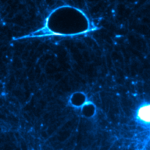Link to Pubmed [PMID] – 28296078
Cell. Microbiol. 2017 Mar;
Botulinum neurotoxins (BoNTs) are responsible for severe flaccid paralysis by inhibiting the release of acetylcholine at the neuromuscular junctions. BoNT type B (BoNT/B) most often induces mild forms of botulism with predominant dysautonomic symptoms. In food borne botulism and botulism by intestinal colonisation such as infant botulism, which are the most frequent naturally acquired forms of botulism, the digestive tract is the main entry route of BoNTs into the organism. We previously showed that BoNT/B translocates through mouse intestinal barrier by an endocytosis-dependent mechanism and subsequently targets neuronal cells, mainly cholinergic neurons, in the intestinal mucosa and musculosa. Here, we investigated the entry pathway of BoNT/B using fluorescent C-terminal domain of the heavy chain (HcB), which is involved in the binding to specific receptor(s) and entry process into target cells. While the combination of gangliosides GD1a /GD1b /GT1b and synaptotagmin I and to a greater extent synaptotagmin II constitutes the functional HcB receptor on NG108-15 neuronal cells, HcB only uses the gangliosides GD1a /GD1b /GT1b to efficiently bind to m-ICcl2 intestinal cells. HcB enters both cell types by a dynamin-dependent endocytosis, which is efficiently prevented by Dynasore, a dynamin inhibitor, and reaches a common early endosomal compartment labeled by early endosome antigen (EEA1). In contrast to neuronal cells, HcB uses a Cdc42-dependent pathway to enter intestinal cells. Then, HcB is transported to late endosomes in neuronal cells, whereas it exploits a nonacidified pathway from apical to basal lateral side of m-ICcl2 cells supporting a transcytotic route in epithelial intestinal cells.

